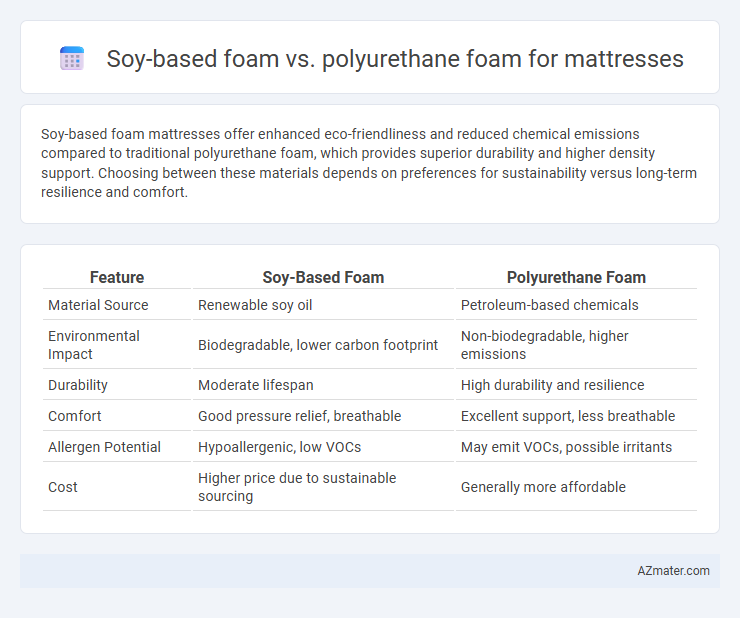Soy-based foam mattresses offer enhanced eco-friendliness and reduced chemical emissions compared to traditional polyurethane foam, which provides superior durability and higher density support. Choosing between these materials depends on preferences for sustainability versus long-term resilience and comfort.
Table of Comparison
| Feature | Soy-Based Foam | Polyurethane Foam |
|---|---|---|
| Material Source | Renewable soy oil | Petroleum-based chemicals |
| Environmental Impact | Biodegradable, lower carbon footprint | Non-biodegradable, higher emissions |
| Durability | Moderate lifespan | High durability and resilience |
| Comfort | Good pressure relief, breathable | Excellent support, less breathable |
| Allergen Potential | Hypoallergenic, low VOCs | May emit VOCs, possible irritants |
| Cost | Higher price due to sustainable sourcing | Generally more affordable |
Introduction to Mattress Foam Types
Soy-based foam offers an eco-friendly alternative to traditional polyurethane foam by incorporating renewable soy oil into its formulation, reducing reliance on petroleum. Polyurethane foam remains the industry standard for mattresses due to its durability, support, and wide range of firmness options. Both foam types provide pressure relief and comfort, but soy-based foam is preferred for those seeking sustainable materials without compromising performance.
What is Soy-Based Foam?
Soy-based foam is a type of polyurethane foam that incorporates soy oil as a partial replacement for petroleum-based polyols, enhancing its eco-friendliness and reducing reliance on fossil fuels. It offers similar support, durability, and comfort levels as traditional polyurethane foam but with lower emissions of volatile organic compounds (VOCs). Mattresses made with soy-based foam provide a more sustainable and environmentally conscious option while maintaining hypoallergenic and pressure-relieving properties.
What is Polyurethane Foam?
Polyurethane foam is a versatile polymer material widely used in mattress production due to its excellent cushioning and durability properties. Created through the chemical reaction of polyols and isocyanates, it offers customizable firmness levels, making it ideal for various sleep preferences. This foam type provides strong support and resilience, often enhanced with additives to improve breathability and reduce off-gassing compared to traditional foams.
Key Differences Between Soy-Based and Polyurethane Foam
Soy-based foam, derived from renewable soy oil, offers enhanced eco-friendliness and lower off-gassing compared to traditional polyurethane foam, which is petroleum-based and may emit more volatile organic compounds (VOCs). Polyurethane foam typically provides higher durability and consistent support, while soy-based foam tends to have better breathability and a softer, more natural feel. The thermal insulation properties and biodegradability of soy-based foam make it a preferred choice for environmentally conscious consumers seeking sustainable mattress materials.
Environmental Impact Comparison
Soy-based foam mattresses significantly reduce environmental impact by utilizing renewable soy oil, which lowers reliance on petroleum-based materials and decreases greenhouse gas emissions during production. Polyurethane foam, derived from non-renewable petrochemicals, contributes to higher carbon footprints and releases toxic chemicals during manufacturing and disposal. Soy-based foams offer enhanced biodegradability and lower levels of harmful volatile organic compounds (VOCs), promoting healthier indoor air quality and sustainable waste management.
Comfort and Support: Which Performs Better?
Soy-based foam offers enhanced breathability and contouring properties, providing superior pressure relief and comfort by adapting closely to the body's shape. Polyurethane foam, known for its dense structure, delivers robust support and durability, ensuring long-lasting resilience and firmness ideal for maintaining spinal alignment. In terms of comfort and support performance, soy-based foam excels in softness and eco-friendly appeal, while polyurethane foam remains the preferred choice for firmer support and longevity.
Durability and Longevity
Soy-based foam mattresses offer enhanced durability due to their natural resistance to breakdown and microbial growth, extending mattress life. Polyurethane foam, traditionally used, tends to degrade faster under constant pressure and heat, reducing longevity. The incorporation of soy components in foam formulation improves cell structure stability, resulting in longer-lasting support and comfort compared to standard polyurethane foam.
Health and Safety Considerations
Soy-based foam mattresses offer lower levels of volatile organic compounds (VOCs) and chemicals compared to traditional polyurethane foam, reducing potential respiratory irritants and allergens. The natural origin of soy-based foam results in fewer synthetic additives, which enhances indoor air quality and minimizes off-gassing odors. Polyurethane foam, while durable, often contains flame retardants and petrochemicals that may pose long-term health risks through prolonged exposure.
Cost Comparison: Soy-Based vs Polyurethane Foam
Soy-based foam typically costs 20-30% more than conventional polyurethane foam due to its renewable soy oil content and eco-friendly manufacturing process. Polyurethane foam remains the more economical choice for mattress production, with prices averaging $10 to $15 per cubic foot compared to $12 to $20 per cubic foot for soy-based alternatives. Pricing variations depend on foam density, processing methods, and regional raw material availability.
Which Mattress Foam Is Best for You?
Soy-based foam offers a more eco-friendly and sustainable alternative to traditional polyurethane foam, with improved breathability and responsiveness that supports pressure relief and temperature regulation. Polyurethane foam, widely known for its durability and cost-effectiveness, provides firmer support but may retain more heat and contain higher levels of volatile organic compounds (VOCs). Choosing the best mattress foam depends on your priorities: prioritize soy-based foam for natural materials and cooling comfort, or polyurethane foam for affordability and firmer support.

Infographic: Soy-based foam vs Polyurethane foam for Mattress
 azmater.com
azmater.com